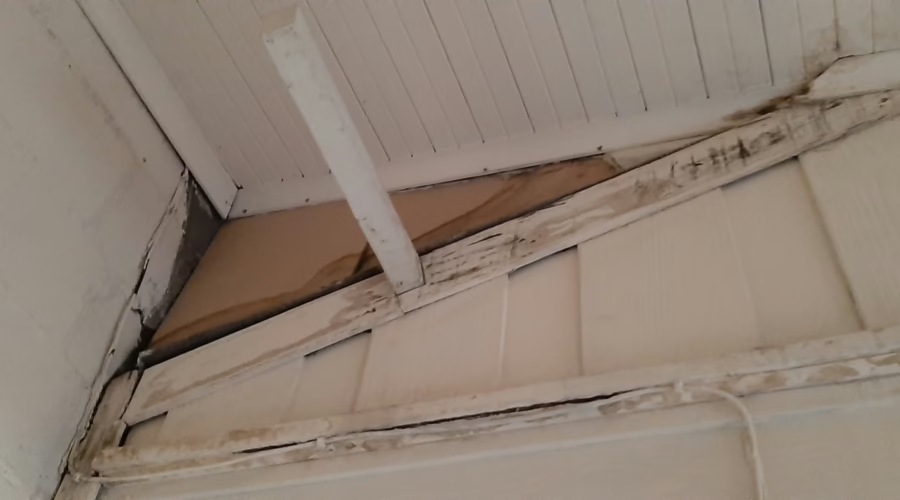Water Damage and Shoddy Construction – When Leaks Expose Deeper Flaws
Introduction
Water damage is more than just an eyesore—it is a glaring indicator of structural neglect. A photograph of internal walls riddled with water stains caused by a leaking roof sheds light on the dire conditions some occupants face. Beyond the visible damage, this situation points to poor construction practices and the dangerous consequences of deferred maintenance.
Understanding the Impact of Water Damage
Water damage from a leaking roof can wreak havoc on a property, resulting in:
- Structural Compromise
- Persistent exposure to water weakens the structural integrity of walls and ceilings.
- Shoddily constructed internal walls are particularly vulnerable to collapse or further degradation.
- Health Hazards
- Water damage creates a breeding ground for mold, mildew, and bacteria, all of which pose severe health risks, including respiratory issues and allergic reactions.
- Financial Costs
- Neglecting water damage can escalate repair costs over time, burdening landlords, municipalities, and occupants alike.
- Loss of Livability
- A home with water-damaged walls is unsafe, unsanitary, and emotionally distressing for its occupants.
Legal Framework Protecting Occupants
Addressing water damage and ensuring structural soundness is not optional. South African law provides robust protections for occupants:
- Rental Housing Act (1999)
- Section 5(1) obliges landlords to maintain rental properties in a habitable condition, free from hazards such as water intrusion and structural instability.
- National Building Regulations and Building Standards Act (1977)
- Requires that buildings be constructed and maintained to withstand environmental conditions, including rainfall. Substandard walls or roof construction violate these standards.
- National Health Act (2003)
- Compels municipalities to act on complaints of housing conditions that endanger public health, including water-damaged, mold-infested interiors.
- Constitution of South Africa (1996)
- Section 24 entitles everyone to an environment that is not harmful to their health or well-being. Living in water-damaged housing is a direct contravention of this constitutional right.
Municipal Responsibilities
When water damage and substandard construction are reported, municipalities are legally obligated to:
- Investigate the complaint and assess the structural and health implications.
- Enforce compliance with building regulations and health bylaws.
- Take corrective action if the responsible party fails to address the issue, including imposing fines or initiating repairs.
Occupants’ Rights and Options
- File a Formal Complaint
- Notify the landlord in writing about the water damage, including photographic evidence. If the landlord fails to act, escalate the complaint to municipal health and building departments.
- Legal Recourse
- Tenants or occupants can approach housing tribunals or initiate legal action under the Promotion of Administrative Justice Act (2000) to compel action.
- Public Advocacy
- Sharing such issues in public forums raises awareness and creates pressure for accountability. This is a last resort when other remedies have been exhausted.
What Water Damage Signals
Leaking roofs and water-damaged internal walls often signify broader issues, such as:
- Inferior construction materials or techniques.
- Delayed or inadequate maintenance of the roof and walls.
- Poor municipal oversight in enforcing building regulations.
If left unaddressed, these problems worsen with time, endangering occupants and increasing the eventual cost of remediation.
Conclusion
Water damage from leaking roofs is a tangible manifestation of neglect—neglect by landlords, municipalities, or both. Addressing such issues promptly is not only a legal obligation but a moral imperative to uphold the dignity and safety of occupants. Structural flaws and water intrusion are more than inconveniences; they are a call to action for accountability and adherence to building standards.
Legal Context for the Right to Publish
This article is published in accordance with Section 16 of the Constitution of South Africa (1996), which guarantees the right to freedom of expression and to receive and impart information. It is further supported by the Promotion of Access to Information Act (2000), ensuring the public’s right to expose health and safety hazards. The Open Justice Principle underlines the importance of public awareness in holding responsible parties accountable for substandard living conditions.


